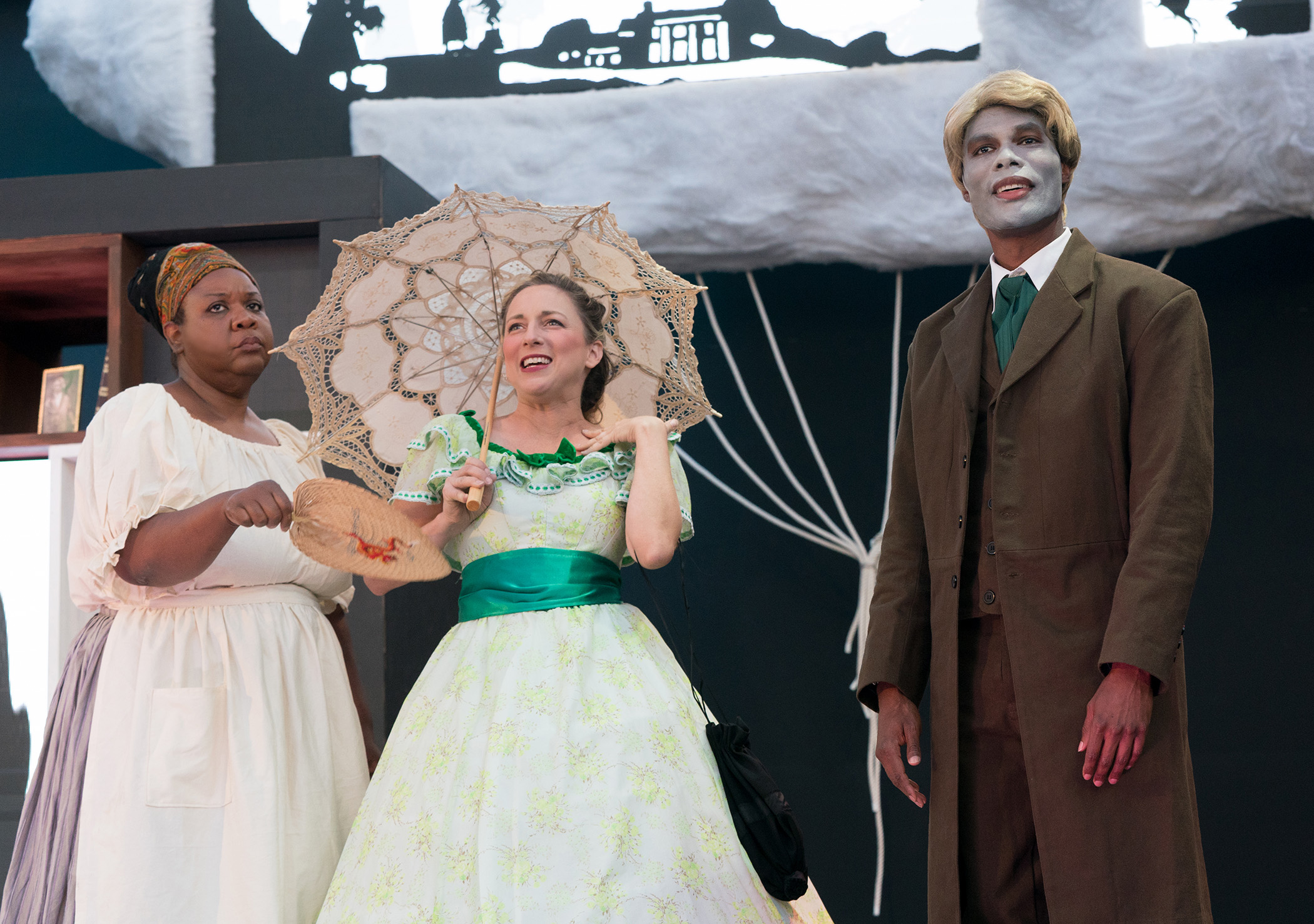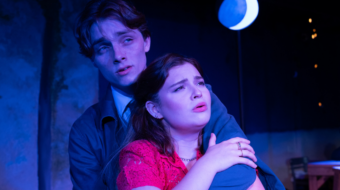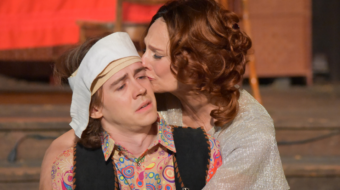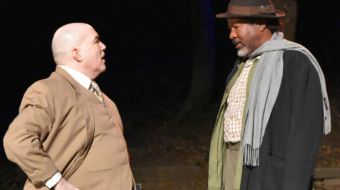
LOS ANGELES—In that “the show must go on” spirit, live theater is returning to Los Angeles stages. On what used to be its adjoining parking lot, the Fountain Theatre has built an impressive Outdoor Stage, an open-air, socially-distanced 99-seater. So, to reverse Joni Mitchell’s admonishment in “Big Yellow Taxi,” “They paved a parking lot, And put up a playhouse.” Along with the excitement of seeing old familiar faces who’d survived the plague year-plus, your humble scribe looked forward to reviewing his first play, in person, in about 15 months.
The opening of An Octoroon is no Welcome Back, Kotter salutation, however, inviting spectators to return to the thrill, spectacle and sheer joy of watching actors in the flesh tread the boards. Instead, it consists of Matthew Hancock in his undergarments identifying himself as a “Black playwright” and proceeding to more or less berate his audience (a mixed-race crowd but probably, like America itself, majority white), while he applies whiteface. Hancock is apparently not a dramatist in real life, though, but rather a Stage Raw and Ovation award-winning actor, and his haranguing of his audience wore thin pretty quickly. After more than a year away from the live stage and surviving a plague, I started wistfully dreaming of enjoying a frothy, toe-tapping Cole Porter musical, some mindless entertainment to take my addled mind off of, well, Dear Reader, you-know-what.
But this is not only a year-plus into a pandemic, it is also an era of a much-needed racial reckoning, where even the high-larious Ziwe is subverting the TV talk show/variety format to explore racism on Showtime and other platforms. While Hancock may not be an African-American playwright, Obie Award winner and MacArthur Fellow Branden Jacobs-Jenkins is, and his play An Octoroon is a cleverly concocted work that deconstructs racial caricatures and tropes with as much zest as the Fountain did in constructing its great new Outdoor Stage.

In his thought-provoking play, Jacobs-Jenkins deals with what is, to me, one of the most fascinating subjects—stereotypes and the debunking and exposing of these myths that are usually imposed by the “other” (typically a member of the dominant majority culture) on the “self” (a member of the ethnic minority being depicted). I myself have authored/co-authored four film history books that all deal with celluloid stereotypes—in particular, of Polynesians—and I personally find this topic to be endlessly interesting, although I’m not really quite sure why this subject obsesses me (unless it represents some kind of a quest for truth and authenticity). In any case, in An Octoroon racial misrepresentation gets the treatment from a Genius Grant recipient, and the audience is in for the equivalent of an intellectual rollercoaster ride.
An Octoroon is set way down yonder in the land of cotton during the antebellum period. As such, among many other things, it provides a dramatization of and peek at the plantation pecking order in the South—and Terrabonne is no Octoroon’s garden under the sea. The play’s eponymous character, Zoe (Mara Klein), is so-called because one eighth of her bloodline is of African ancestry, which legally, as well as culturally, complicates matters with all sorts of racial baggage in that realm of bondage. In particular, there are ramifications for Zoe’s budding romance with George (played by Hancock in whiteface and a blonde wig), a cultured Caucasian who has just returned from Paris, with a penchant for that new art form, photography, and a family tie to the owners of Terrabonne, the Louisiana plantation where most of the action takes place. The plot is more complex because the well-to-do Dora (actress playwright Vanessa Claire Stewart in a double role, including portraying a ship’s captain), a stereotypical antebellum belle, hopes to woo George.
Now, to make matters even more complicated, Jacobs-Jenkins’s An Octoroon is actually an adaptation and deconstruction of an actual 19th-century melodrama by Dionysius Lardner Boucicault, The Octoroon. So, you have a modern-day Black playwright rendering an updated iteration of a production created by a dramatist who was white. (Adding yet another level of genealogical complexity, Boucicault’s play adapted Thomas Mayne Reid’s novel The Quadroon.)
Boucicault, depicted onstage by Rob Nagle, was actually born (out of wedlock) in Dublin, and like Seán O’Casey and George Bernard Shaw eventually would, he arguably had an Irish sensibility. And coming from a land and people oppressed by British occupation and colonialism, Boucicault’s sensationalistic original melodrama seems to have empathy for the enslaved Blacks and for the romantic quandary George and Zoe are ensnared in down in Dixie.
(According to Jessica Traynor, deputy museum director at EPIC The Irish Emigration Museum, Boucicault also wrote Arrah na Pogue (1864) and The Shaughraun (1875). These plays were based around the United Irish rebellion and the Fenian Uprising, and both revolved around well-meaning gentry punished for their aid of Ireland’s bid for freedom, the machinations of villainous middlemen, and the wily cunning of the native Irish people.”)
The Octoroon opened in New York City only four days after abolitionist John Brown—arguably the greatest white American who ever trod the sod—was hanged for fomenting a slave rebellion at Harpers Ferry in what is now West Virginia. Although according to press notes, reaction to Boucicault’s 1859 play were mixed, The Octoroon was considered to be “controversial” because of its depictions of slavery, lynching, interracial love and more. (Let’s not forget that during the Civil War President Lincoln supposedly called the author of that anti-slavery classic Uncle Tom’s Cabin, Harriet Beecher Stowe, “the little lady who made this big war.”)
And to further muddy the melodramatic waters, instead of keeping things, so to speak, black and white, Boucicault injects a third ethnicity into the stew, an indigenous character. The Native part is also played in redface by Nagle, which is ironic, as Boucicault, who was an actor as well as a bard, himself essayed the role of Wahnotee. (And don’t even get me started on the nonhuman character, Br’er Rabbit, portrayed by Leea Ayers, who also plays the pregnant slave Grace.)
An Octoroon’s plot is convoluted, but suffice it to say that Jacobs-Jenkins renders his vision with absurdist verve and Brechtian techniques. Hancock, who plays three roles, deserves special kudos for his scene-stealing turn that had him play two of his characters while they interacted, which was an audience favorite and reminiscent of the droll stage adaptation of the Alfred Hitchcock classic The 39 Steps. Given the centrality that video recordings by the courageous Darnella Frazier and others have played in the Black Lives Matter movement, it’s intriguing to note the key role that George’s camera plays in An/The Octoroon.
Screens are incorporated into the Fountain’s Outdoor Stage, and the imagery projected onto them seems to include Kara Walker’s black cut-paper silhouettes, which are harrowing depictions of slavery. In 2019 The Irish Times dubbed Dublin-born Boucicault “The king of Victorian sensation theatre,” and his melodramas were known for their special effects (which required intricate stagecraft), just as today’s blockbuster movies are full of whizbang special FX.

However, audiences must be prepared for some of the imagery that fills these screens, in particular during the intermission of this two-and-a-half-hour extravaganza. Other images include actors in blackface, such as Shirley Temple; the singing of “Zip-a-Dee-Doo-Dah”; outrageously caricaturish color cartoons of “buffoonish” Blacks; and Mickey Rooney as a bucktoothed J-word in 1961’s Breakfast at Tiffany’s (what an “Octo-Rooney”!); and more. There is also a promiscuous use of the N-word that might even make Issa Rae, whose HBO show gratuitously uses the term nonstop, blush, plus an endless stream of obscenities. A projected photo of a lynching dawdles too long onstage (the entire play could easily be cut by 30 minutes).
An Octoroon is definitely not for children and easily offended adults. Yet those who might seek to ban Octoroon are the same types who’d try to “cancel” critical race theory and The 1619 Project, which also try to put race and racism into a 21st-century context, construct and perspective. These are the fears of the descendants of the culprits, the guilty perpetrators terrified to look inward and beyond the myths, frightened they’ll be held accountable for the actions of their ancestors which they benefited from, as well as their own contemporary racism which they want to continue to inflict without the inconvenient truth of being labeled for what they are: racists.
Considering the unconventional casting that crosses gender and, Hamilton-like, ethnic boundaries, An Octoroon is all the more interesting, considering that circa 1859 “Black characters were played by White actors in blackface because Black actors were not allowed on stage,” according to dramaturge Dr. Daphne Sicre. (It remains to be seen if any of the eight actors indulging in whiteface, blackface and redface will one day be—context be damned!—“punished” for doing so, as others have been.) In any case, self-determination in the arts means that the “self”—and not the “other”—determines how it is represented.
Performed under the stars, An Octoroon is an ideal play to commemorate the spirit of Juneteenth, an auspicious launch and return to the stage for the theater-craving public. Cole Porter and entertaining distractions have their place in the firmament of the theater, but in our troubled time, as racism and the struggle against this vile, wicked, evil most foul roil our world, we also need productions that challenge, inspire and enlighten audiences to grapple with how to bring about equality and justice for all. Bravo, Fountain: well done and welcome back, ye sly subverters of the status quo.
STRANGE FACT OF THE REVIEW: One of 19th-century America’s most (in)famous actors, John Wilkes Booth, preempted The Octoroon, which, according to press notes, was scheduled for a twelve-performance run at Washington, D.C.’s Ford’s Theatre and would have opened immediately following Lincoln’s assassination there on April 14, 1865. Yet another reason to hate this pro-Confederate scumbag!
An Octoroon: plays through Sept. 19, Fri. at 7 p.m. (dark July 30 and Aug. 27), Sat. at 7 p.m. (dark July 31 and Aug. 28), Sun. at 7 p.m. (dark Aug. 1 and Aug. 29), and Mon. at 7 p.m. (dark Aug. 2 and Aug. 30).
The Fountain Theatre is located at 5060 Fountain Ave. (at Normandie), Los Angeles 90029. For tickets and further information call (323) 663-1525 or go to the company website.










